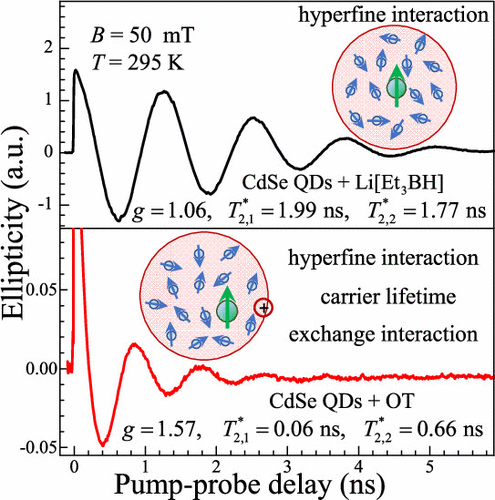当前位置:
X-MOL 学术
›
J. Phys. Chem. Lett.
›
论文详情
Our official English website, www.x-mol.net, welcomes your
feedback! (Note: you will need to create a separate account there.)
Hole-Acceptor-Manipulated Electron Spin Dynamics in CdSe Colloidal Quantum Dots
The Journal of Physical Chemistry Letters ( IF 4.8 ) Pub Date : 2021-02-24 , DOI: 10.1021/acs.jpclett.0c03669 Zhen Wu 1 , Yuanyuan Zhang 1 , Rongrong Hu 2 , Meizhen Jiang 1 , Pan Liang 3 , Qing Yang 1 , Li Deng 4 , Tianqing Jia 1 , Zhenrong Sun 1 , Donghai Feng 1, 5
The Journal of Physical Chemistry Letters ( IF 4.8 ) Pub Date : 2021-02-24 , DOI: 10.1021/acs.jpclett.0c03669 Zhen Wu 1 , Yuanyuan Zhang 1 , Rongrong Hu 2 , Meizhen Jiang 1 , Pan Liang 3 , Qing Yang 1 , Li Deng 4 , Tianqing Jia 1 , Zhenrong Sun 1 , Donghai Feng 1, 5
Affiliation

|
Electron spin dynamics in CdSe quantum dots with hole acceptors are investigated by time-resolved ellipticity spectroscopy. Two types of hole acceptors, Li[Et3BH] and 1-octanethiol, result in distinctly different electron spin dynamics. The differences include electron g factors, spin dephasing/relaxation times, and mechanisms. In CdSe quantum dots with Li[Et3BH], the electron spin dephasing and relaxation are dominated by electron–nuclear hyperfine interactions in zero and weak magnetic fields. In contrast, hyperfine interactions, electron carrier lifetimes, and exchange interactions between electrons and holes or surface dangling bond spins control the electron spin dynamics in CdSe quantum dots with 1-octanethiol. Inhomogeneous dephasing limits the spin coherence time in larger transverse magnetic fields for both hole acceptor cases, but with distinct different g-factor inhomogeneity. These findings manifest that surface conditions play an important role in the spin dynamics and that thereby the surface and its surroundings can be exploited to control the spin in colloidal nanostructures.
中文翻译:

CdSe胶体量子点中空穴受体操纵的电子自旋动力学
通过时间分辨椭圆光谱研究了带有空穴受体的CdSe量子点中的电子自旋动力学。两种类型的空穴受体Li [Et 3 BH]和1-辛烷硫醇导致明显不同的电子自旋动力学。差异包括电子g因子,自旋相移/弛豫时间和机制。在具有Li [Et 3的CdSe量子点中[BH],电子自旋移相和弛豫主要由零磁场和弱磁场中的电子核超精细相互作用引起。相反,超精细相互作用,电子载流子寿命以及电子与空穴或表面悬挂键自旋之间的交换相互作用控制具有1-辛硫醇的CdSe量子点中的电子自旋动力学。对于两个空穴受体情况,不均匀的相移限制了较大横向磁场中的自旋相干时间,但是具有明显不同的g因子不均匀性。这些发现表明,表面条件在自旋动力学中起着重要作用,因此可以利用表面及其周围环境来控制胶体纳米结构中的自旋。
更新日期:2021-03-04
中文翻译:

CdSe胶体量子点中空穴受体操纵的电子自旋动力学
通过时间分辨椭圆光谱研究了带有空穴受体的CdSe量子点中的电子自旋动力学。两种类型的空穴受体Li [Et 3 BH]和1-辛烷硫醇导致明显不同的电子自旋动力学。差异包括电子g因子,自旋相移/弛豫时间和机制。在具有Li [Et 3的CdSe量子点中[BH],电子自旋移相和弛豫主要由零磁场和弱磁场中的电子核超精细相互作用引起。相反,超精细相互作用,电子载流子寿命以及电子与空穴或表面悬挂键自旋之间的交换相互作用控制具有1-辛硫醇的CdSe量子点中的电子自旋动力学。对于两个空穴受体情况,不均匀的相移限制了较大横向磁场中的自旋相干时间,但是具有明显不同的g因子不均匀性。这些发现表明,表面条件在自旋动力学中起着重要作用,因此可以利用表面及其周围环境来控制胶体纳米结构中的自旋。































 京公网安备 11010802027423号
京公网安备 11010802027423号